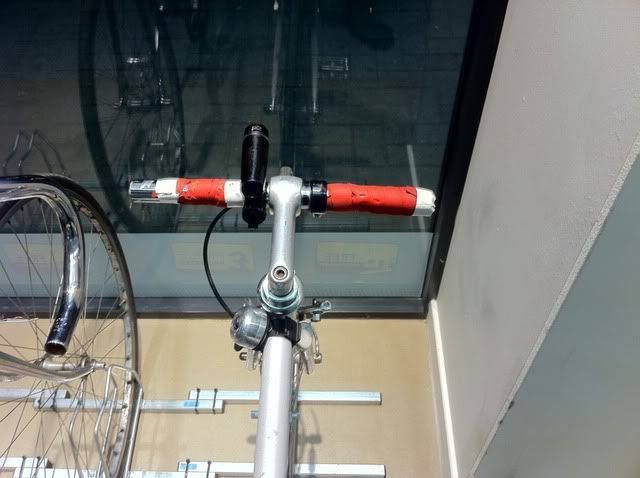-
• #15377
There's also the surface to take into consideration.
-
• #15378
There's also the surface to take into consideration.
Do you have a reference for this? It gets dragged up every time rolling resistance is mentioned, but so far all the available data seems to confirm that the ranking of tyres by rolling resistance tested on a smooth drum holds good on rough surfaces
-
• #15379
What I meant was that using a smaller tyre would soak up less discrepancies in a surface therefore increasing the rolling resistance.
Running larger/smaller tyres on a perfectly smooth surface would make no difference if the tyres were at the usual pressure (8/9bar) as there wouldn't be much tyre deformation causing more resistance.
I don't have any articles as I'm not that interested in the subject really. I've always used 18/19mm tubs on very smooth tracks as I could pump them up to about 16bar. For most outdoor tracks I used 23mm tubs as they were the most easily available for a decent price.
-
• #15380

So close, so far.
-
• #15381

Another 3G in the front and a different bar/stem combo (with tape) and it would be awesome.
-
• #15382
why don't they ride fat tyres in the Tour? .
Coz when you are 5st piss-wet through and floating along off your tits on druuuuugs, there's fick-all casing deflection anyway.
-
• #15383
:)
-
• #15384
looking at the other pics - that is just a sex swing on wheels!
fail or win? i'm not sure
Not sure that would be a type of sex that I would want to see on the streets and trails near me... yikes.
-
• #15385
RPM's favourite handlebar with no room for the bell that's now installed on the top tube instead (single speed too);

-
• #15386
plenty of space there, to pull fast coming up a hill....
-
• #15387
the left bar definitely looks longer aswell...
-
• #15388

bitch, please
-
• #15389
^go back a page, eeeerpost
-
• #15390
Came across this using StumbleUpon:
brakeless custom bike
the montreal bike shop brakeless created this custom bike for one of their employee’s. the bike features
a range of gear that is sourced from many different companies. the frame by marinoni is particularly
interesting, featuring a small cut-out on the bottom to allow the rear wheel to be indented into the frame.
-
• #15391
what an ugly bike, omg...
-
• #15392
I'm pretty sure that's only a render though... not that it's likely to look any better in real life.
-
• #15393
Wow not a single redeeming quality...
-
• #15394
Somehow this is a bike:

-
• #15395
Somehow this is a bike:


-
• #15396

Hahaha. Didn't realise till i saw this picture.
-
• #15397

-
• #15398
Iwas about to say it wouldn't be so bad with different ... but the list kept getting longer and longer.
Yeah it's shit.
-
• #15399
pretty much my thoughts....
-
• #15400
Is he having a laugh?
http://www.gumtree.ie/dublin/71/73818771.htmlhahaha best bit "it has a gear ratio of 42"
thats some tough gearing.
 O'Shane
O'Shane gbj_tester
gbj_tester MechaMorgan
MechaMorgan TheFinalHour
TheFinalHour edscoble
edscoble rik
rik chiroshi
chiroshi Louiee
Louiee JesperXT
JesperXT scorch
scorch TM
TM spotter
spotter F34Rthefixed
F34Rthefixed @flickwg
@flickwg
Not bollocks, but they have ignored the dominance of aerodynamics at high speeds. Total resistance to forward motion is the sum of rolling resistance and aerodynamic drag (+some minor bits and pieces), and the ideal balance depends on the target speed, since drag rises as the square of speed while rolling resistance is essentially constant. In fact, there is a move towards slightly wider tyres in pro road racing, but only a couple of millimetres.
Part of the reason for the origin and persistence of the fallacy that narrow tyres roll faster is that casing stress rises with tyre pressure and sectional radius, so for a given stress one must either reduce pressure (and thus raise rolling resistance) or increase casing thickness (again raising rolling resistance) if the casing section is increased. Also, historically, only narrow 'racing' tyres were made with the thin treads and casings which give low rolling resistance. The key phrase in the article is " All other factors being equal" - the fact is, they are seldom equal since people who want wide tyres usually also want long lasting treads and highly resistant casings. If you cut tyres of different sections from the same cloth, and apply the same tread band, wider tyres will have lower rolling resistance, even if you lower the pressure in the bigger tyres to maintain constant casing stress.